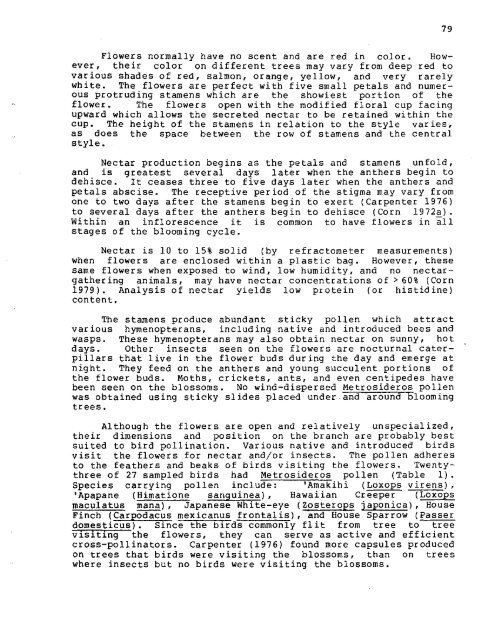June 1 - 3 , 1978 - University of Hawaii at Manoa
June 1 - 3 , 1978 - University of Hawaii at Manoa
June 1 - 3 , 1978 - University of Hawaii at Manoa
You also want an ePaper? Increase the reach of your titles
YUMPU automatically turns print PDFs into web optimized ePapers that Google loves.
Flowers normally have no scent and are red in color. How-<br />
ever, their color on different trees may vary from deep red to<br />
various shades <strong>of</strong> red, salmon, orange, yellow, and very rarely<br />
white. The flowers are perfect with five small petals and numer-<br />
ous protruding stamens which are the showiest portion <strong>of</strong> the<br />
flower. The flowers open with the modified floral cup facing<br />
upward which allows the secreted nectar to be retained within the<br />
cup. The height <strong>of</strong> the stamens in rel<strong>at</strong>ion to the style varies,<br />
as does the space between the row <strong>of</strong> stamens and the central<br />
style.<br />
Nectar production begins as the petals and stamens unfold,<br />
and is gre<strong>at</strong>est several days l<strong>at</strong>er when the anthers begin to<br />
dehisce. It ceases three to five days l<strong>at</strong>er when the anthers and<br />
petals abscise. The receptive period <strong>of</strong> the stigma may vary from<br />
one to two days after the stamens begin to exert (Carpenter 1976)<br />
to several days after the anthers begin to dehisce (Corn 1972~).<br />
Within an inflorescence it is common to have flowers in all<br />
stages <strong>of</strong> the blooming cycle.<br />
Nectar is 10 to 15% solid (by refractometer measurements)<br />
when flowers are enclosed within a plastic bag. However, these<br />
same flowers when exposed to wind, low humidity, and no nectar-<br />
g<strong>at</strong>hering animals, may have nectar concentr<strong>at</strong>ions <strong>of</strong> >60% (Corn<br />
1979). Analysis <strong>of</strong> nectar yields low protein (or histidine)<br />
content.<br />
The stamens produce abundant sticky pollen which <strong>at</strong>tract<br />
various hymenopterans, including n<strong>at</strong>ive and introduced bees and<br />
wasps. These hymenopterans may also obtain nectar on sunny, hot<br />
days. Other insects seen on the flowers are nocturnal c<strong>at</strong>er-<br />
pillars th<strong>at</strong> live in the flower buds during the day and emerge <strong>at</strong><br />
night. They feed on the anthers and young succulent portions <strong>of</strong><br />
the flower buds. Moths, crickets, ants, and even centipedes have<br />
been seen on the blossoms. No wind-dispersed Metrosideros pollen<br />
was obtained using sticky slides placed under and around blooming<br />
trees.<br />
Although the flowers are open and rel<strong>at</strong>ively unspecialized,<br />
their dimensions and position on the branch are probably best<br />
suited to bird pollin<strong>at</strong>ion. Various n<strong>at</strong>ive and introduced birds<br />
visit the flowers for nectar and/or insects. The pollen adheres<br />
to the fe<strong>at</strong>hers and beaks <strong>of</strong> birds visiting the flowers. Twentythree<br />
<strong>of</strong> 27 sampled birds had Metrosideros pollen (Table 1).<br />
Species carrying pollen include: 'Amakihi (Loxops virens) ,<br />
'Apapane (Him<strong>at</strong>ione sariguinea), <strong>Hawaii</strong>an Creeper (Loxops<br />
macul<strong>at</strong>us m)<br />
, Japanese White-eye (Zosterops japonica) , House<br />
-rpodacus mexicanus frontalis), and House Sparrow (Passer<br />
domesticus). Since the birds commonly flit from tree to tree<br />
visiting the flowers, they can serve as active and efficient<br />
cross-pollin<strong>at</strong>ors. Carpenter (1976) found more capsules produced<br />
on trees th<strong>at</strong> birds were visiting the blossoms, than on trees<br />
where insects but no birds were visiting the blossoms.
















